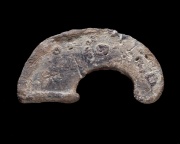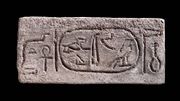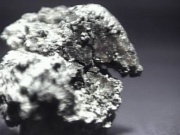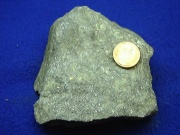Lead
Description
A soft, dense metallic element. The silvery, gray malleable metal occurs naturally most often as a sulfide in the mineral Galena. Other lead minerals include Anglesite (lead sulfate) and Cerussite (lead carbonate). Lead is mined in China, Australia, United States, Peru, Mexico, India, Canada, Sweden, Poland, Ireland. Metallic lead is shiny when freshly cut, but quickly oxidizes in air. It is easily melted, cast, rolled, and extruded. Native metallic lead was found and used from about 3600-2600 BCE when the technique for obtaining lead from roasting the sulfide ore (galena) was discovered. Lead was used to make small cast items such as coins and statuettes as well as larger items such as plumbing pipes, spires, statues, cisterns, and gargoyles. Although recent use has decreased, lead has also been used for pigments (Lead white, Litharge, Orange mineral, etc.) and as a component in pottery glazes. It has also been used for roofing, flashing, plumbing, stained glass windows, and as a soft solder. Because of its density, lead is also used for radiation shielding.
Synonyms and Related Terms
Pb; plumbum; Lood (Ned.); plomb (Fr.); Blei (Deut.); piombo (It.); chumbo (Port.); plomo (Esp.); Bly (Sven.); olovo (Ces.); bly (Dan., Nor.);
Risks
- Cumulative toxicity on ingestion or inhalation of dust, lead fumes or lead salts.
- May cause anemia, weakness, vomiting, convulsions
- GSC International: SDS
Physical and Chemical Properties
Flame color is light blue. Soluble in dilute nitric acid. Insoluble in sulfuric acid. Attacked by pure water and weak organic acids.
Potassium dichromate may be used for the colorimetric detection of lead in objects. It reacts with lead to form bright yellow lead chromate crystals.
| Composition | Pb (atomic no. 82) |
|---|---|
| CAS | 7439-92-1 |
| Mohs Hardness | 1.0 |
| Melting Point | 327.4 C |
| Density | 11.3437 g/ml |
| Molecular Weight | at. wt. = 207.22 |
| Boiling Point | 1740 C |
Resources and Citations
- O. Untracht, Metal Techniques for Craftsmen, Doubleday and Co., Garden City, NY, 1968.
- J.Waite, "Architectural Metals: Their Deterioration and Stabilization" in Preservation and Conservation: Principles and Practice, S.Timmons (ed.), Preservation Press, Washington DC, 1976, p. 213.
- Web Elements: Website
- Ancient Trade Routes: Website
- Encyclopedia Britannica, http://www.britannica.com Comment: "lead" [Accessed 25 Jan. 2006].
- Wikipedia: http://en.wikipedia.org/wiki/Lead (Accessed Feb. 2, 2006)
- G.S.Brady, Materials Handbook, McGraw-Hill Book Co., New York, 1971
- Ralph Mayer, A Dictionary of Art Terms and Techniques, Harper and Row Publishers, New York, 1969 (also 1945 printing)
- Dictionary of Building Preservation, Ward Bucher, ed., John Wiley & Sons, Inc., New York City, 1996
- Encyclopedia of Archaeology, Glyn E. Daniel, ed., Thomas Y. Crowell Co., New York, 1977
- David C. Scott, Metallography and Microstructure of Ancient and Historic Metals, The Getty Conservation Institute, Los Angeles, 1991
- Tom Rowland, Noel Riley, A-Z Guide to Cleaning, Conserving and Repairing Antiques, Constable and Co., Ltd., London, 1981
- Michael McCann, Artist Beware, Watson-Guptill Publications, New York City, 1979
- Jack Odgen, Jewellery of the Ancient World, Rizzoli International Publications Inc., New York City, 1982
- A.Lucas, J.R.Harris, Ancient Egyptian Materials and Industries, Edward Arnold Publishers Ltd., London, 4th edition, 1962



